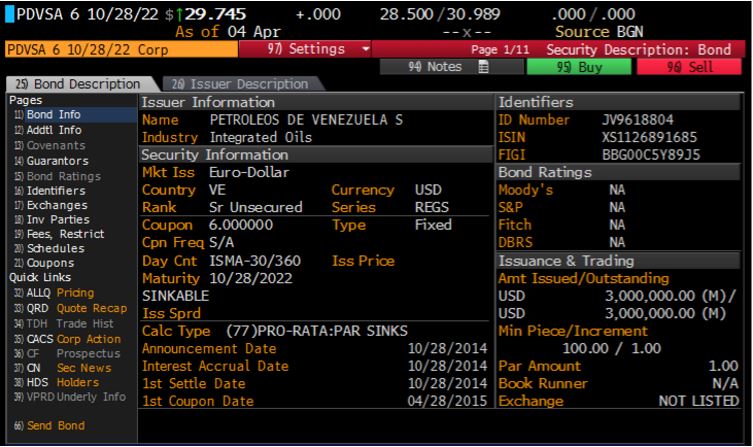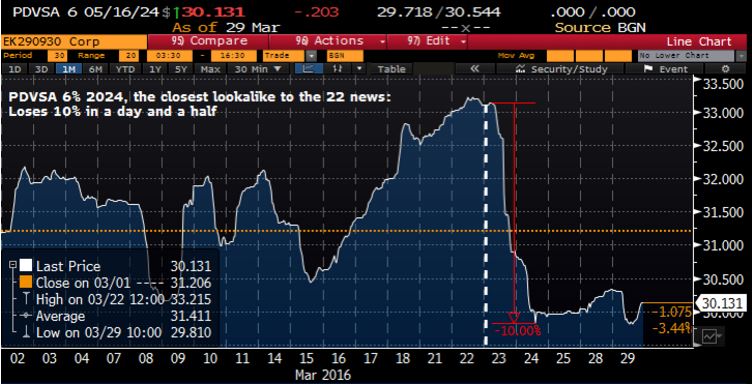Pdvsa 22 New, A Trader's-Eye-View
Seventeen months after a bizarre, closed-doors deal between PDVSA, Banco de Venezuela and BCV, a “new” Pdvsa 6% 2022 bond turned up and fell a hair-raising 11% in its first day of ‘trading’. We set out to figure out what the hell that’s about.


It was miércoles santo. Despite President Maduro giving everybody the week off by decree, most of the local traders, like me, were online on their Bloomberg terminals, keeping an eye on their positions and aiming to leave early. Little did we suspect that night that a strange, middle-of-the-night decision made 17 months earlier in a desperate bid to roll-over maturing Pdvsa ‘14 bonds was about to detonate across our terminals.
So I was just casually chatting about the Venny market, which seemed to be more active than usual for the holiday-shortened week, and about oil prices, which were falling faster than they had in a month that day, when I stumbled upon that screen at the top of this post, and immediately shared it on the chat room.
The other traders lost their minds…
Wtf man?!?!
What is that new Pdvsa 6% 22?!?
When did it start to trade?
Why is it going down eleven freakin’ percent in a day??
Who’s pricing this?? Who’s selling this??
And most importantly…
Who the hell is BVAL and when did he start trading this bond??
To be clear, Pdvsa 22 “new’s” – as we’ve been calling them, to differentiate from the longer-established Pdvsa 22s – haven’t started to trade for real as of today. That BVAL price source that got all traders panicky turned out to be a nothing more than a Bloomberg robot spitting ‘indicative’ prices (more on that later). I’m not gonna lie, I was a little frightened too. But at least the existence of the Pdvsa 22n didn’t take me by surprise.
The bond was never quite secret, just untraded and opaque as all hell. I’d read about it about a year ago in a piece about Venny by JP Morgan (pages 7 and 19). Back then, the research analyst talked casually about the 3-billion-dollar bond destined to be sold in the secondary market to collect cash, getting back about a third of face value in the process. It’s scary how spot-on the reasoning turned out to be.
Nevertheless, most analysts now figure they’re soon going to be sold through the upcoming DICOM currency market. There’s an ample precedent of this kind of operation, where the government makes dollars available by allowing you to buy bonds for bolivars in Caracas and sell them on for dollars in international markets. Quico’s classic SITME piece from 2011 is a good primer on all that. But times have changed a lot since the good-old days of triple-digit oil prices.
Before this new issue, President Nicolás Maduro had already hatched a couple of ugly ducklings: Pdv ‘26 (Nov-2013) and Pdv ‘24 (May-2014), both of which were mainly used as cannon fodder for the deceased Sicad 2 currency system. They are now famous in the trading community as “low-dollar-price” bonds, a euphemism for almost-worthless: the things trade at about 30% of face value.
Pdvsa 22n is set to join those two sooner rather than later in the low-price ranks. But its arrival is coming amid much worse conditions for the state oil company: WTI crude settled at 102$ per barrel the day Pdvsa 24s were issued, and bond yields were on the 13% area.
The saddest part about the inception of the Pdvsa 22 new? It’s a bastard child.
Despite it having an ISIN code – which is sort of like a bond’s cédula de identidad – and sporting this description on a Bloomberg screen que mete la coba…
…this bond has no publicly available prospectus.
That’s extremely unusual: it’s the prospectus that states the terms of the bond in a standardized legal format. Without one, creditors are at the mercy of the debtor’s whims for getting their money back. I’m still yet to meet the first professional investor willing to invest on a bond that has no public records of its terms, let alone a Venezuelan obligation!
I called the Bloomberg help desk to ask where they got the terms they are showing there, and an indian guy awkwardly wrote me that these came from an Offering Circular sent by the bond’s Lead Manager – the investment bank sponsoring the bond issue – but that all info apart from that was “private”. As if that ever stopped anyone else before. A quick search for the bond ISIN through Euroclear shows Citigroup NA was the bank sending that offering memo.
This excess of secrecy around the issue of the bond is really frustrating. It’s also really scary when you start to connect the dots. As Pedro wrote en caliente last week, the Pdvsa 22 new was conceived in a menage-a-trois in the dark between the oil company, the country’s Central Bank and Banco de Venezuela, by far the largest of the state-owned retail banks back at the end of October 2014.
Nobody outside the boards of these three public entities knows who got royally screwed and ended up forking actual dollars in the transaction: either one of the banks might have had to pay Pdvsa in full for the bonds, and ended up on the hook for a massive $2 billion loss. It’s hard to see Banco de Venezuela having the greenbacks on hand to do that in late 2014, and while it’s not outside the realm of possibility for the Central Bank to have conjured up $2 billion out of some secret, bochinche parafiscal bolthole, it’s clear reserves didn’t fall by that much in one day – we would’ve noticed.
That leaves a third and, to Pdvsa bond investors, even more disheartening possibility: maybe no dollars changed hands at all. Maybe PDVSA just got 62 billion bolivars for the issue back then (as its confusing 2014 financials suggest – page 65); that’s a pitiful $1.24 billion at the SICAD 2 rate of that date, in exchange for a promise to pay $3 billion worth of debt in less than a decade.
So we can’t tell exactly which public entity did the screwing and which one did the getting screwed back then. We can tell that the Pdvsa 22n are the offspring of a really wild night.
And what a coincidence! That same day, Pdvsa 14 bonds were due. You’d almost think the Pdvsa 22n were a desperate, dead-of-night gambit to avoid a looming default by ripping a massive hole in the balance sheet of the one kind of player who literally can’t say no: a Venezuelan state entity.
Trying to make sense of this mess, I ask Bloomberg Help Desk for help again. I was getting scared that the government had already started to sell the bonds in the secondary market, and that this was the reason the bond started to show prices on Bloomberg.
Turns out that the infamous BVAL price source isn’t providing ‘real’ market prices at all, but rather estimations of the ‘fair’ value of the bond, using similar PDVSA securities as a reference. Even though the price makes sense compared with the rest of the PDVSA bonds, the truth is that this indication is a Fugazi: it doesn’t represent any actual trades done with the bond.
After a lot of digging and some phone calls, I pieced together what the fuss seemed to be all about. The Bloomberg price, the BVAL estimation, started to update on march 23rd, the same day a couple of dealers started to fiddle with their electronic trading platforms, putting their best guesses of the market price they expect these PDVSA 6% 22’s would be worth when they actually start changing hands.
When I came back to work the day after figuring out all of this, I hastily open the price screens for pdvsa 22n. I see a dealer showing bid/offer prices for the bond, and I open a chat with him:
Me: Hey, are you trading Pdvsa 22n?
Trader: Yes. 28 bid.
Me: That’s insane, I don’t have any bonds. Nobody is trading them. And I wouldn’t be a seller at 28.
Trader: Wanna try hitting me on ALLQ?*
Me: What happens if I do?
Trader: Nothing, trust me 😉
Me: hahah ok.. I’ll pass. Would be a buyer in any case. Are you selling those?
Trader: Of course not. Nobody is trading this bond.
*slang for clicking a ‘sell’ order on the Bloomberg electronic platform.
Lesson learned: you will never get information out of a seasoned trader without giving away yours.
Well, then… What’s with the big fuss? Pdvsa 22n still aren’t trading, why are they losing -11% in a day? It wasn’t just this fugazi bond that was cratering; active PDVSA bonds were also posting heavy losses on a high-volume session.
That day was carnage, and the explanation is very simple: who in his right mind would be willing to demand bonds now, when there’s three billion dollars of new supply that could enter the market at any moment?
If recent history is any indication, those new Pdvsa 22 bonds should start finding their way into the market before long. The exact timing is a guessing game, that critically affects the FX income of whichever public entity is actually on the hook for these bonds – remember, we still don’t know which one. If we believe in BVAL prices, then either Banco de Venezuela or BCV saw the value of their bond holdings decline from $1.05 bn to $930 mm in the span of one day. That’s a $116 million loss. But it pales in comparison to what happened that crazy night of October 28th, 2014…
Caracas Chronicles is 100% reader-supported.
We’ve been able to hang on for 22 years in one of the craziest media landscapes in the world. We’ve seen different media outlets in Venezuela (and abroad) closing shop, something we’re looking to avoid at all costs. Your collaboration goes a long way in helping us weather the storm.
Donate






